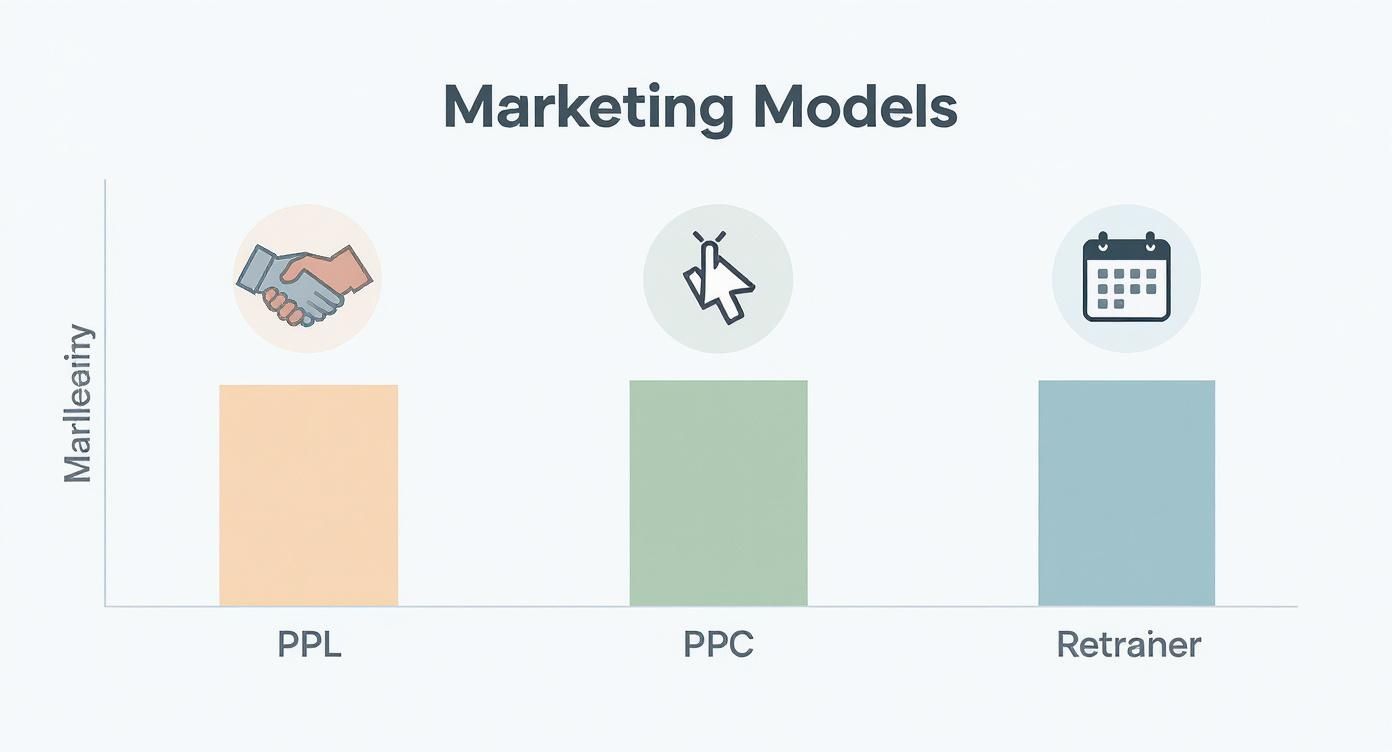What if you only had to pay your sales team when they brought you a genuinely interested customer, instead of paying for all the hours they spent digging for prospects? That’s the simple, powerful idea behind Pay Per Lead (PPL). It's a performance-based approach where you pay a fixed price for each qualified potential customer your marketing partner sends your way.
This model ties your marketing budget directly to real, tangible results. It flips the script on risk—it's no longer on your shoulders, but on your marketing partner's.
Understanding the Pay Per Lead Model

At its core, pay per lead is a beautifully straightforward deal. Forget paying for ad space, clicks, or impressions. With PPL, your business only opens its wallet when you receive a lead—the contact information of someone who has actively shown interest in your services.
Suddenly, the risk of a marketing campaign falling flat isn't your problem anymore. If an ad campaign doesn't bring in good prospects, the lead generation partner absorbs that cost, not you. This built-in accountability gives them a massive incentive to deliver only high-quality, relevant opportunities to your doorstep.
What Exactly Is a "Lead"?
Here’s the thing: a “lead” isn’t some vague concept. It's a specific, pre-defined action that you and your partner agree on beforehand. This clarity is what makes the whole system work so well.
A payable lead could be any number of things, such as:
- A completed contact form on your website.
- A direct phone call from a motivated customer.
- An email inquiry asking for a quote.
- A booked appointment that lands right on your calendar.
This flexibility is key. It lets you define precisely what a new opportunity is worth to you. For a home service business, a live phone call from a homeowner with an urgent repair is a gold-plated, high-intent lead.
Key Takeaway: The pay per lead model hinges on a crystal-clear agreement. You and your partner define what a "qualified lead" looks like, ensuring you only pay for prospects who fit your ideal customer profile and are in your service area.
How PPL Works Behind the Scenes
The process kicks off by establishing the ground rules for what counts as a valid lead. These criteria are your quality control, protecting your budget and making sure you get what you pay for. You'll nail down details like geographic location, the specific service needed, and how to verify contact info right from the start.
With the rules in place, the lead generation company gets to work, using their marketing muscle to find potential customers. They might be running social media ads, optimizing for search engines, or using other tactics to drum up interest.
When someone who fits your criteria raises their hand, their information is captured and sent directly to you. Only then do you pay the agreed-upon price for that lead.
To get the full picture, it's useful to see how PPL differs from other models. For instance, you might want to understand What Is Pay Per Click Advertising Management. While models like PPC charge you for the initial click, PPL focuses on the much more valuable outcome—the lead itself. This distinction is precisely why PPL is such a powerful tool for businesses looking for predictable, efficient growth.
How PPL Compares To Other Marketing Models
Choosing the right marketing approach can feel like placing a wager—each model carries its own blend of risk and reward. Understanding how pay per lead (PPL) stacks up against common alternatives is the first step toward a budget you can forecast with confidence.
Rather than guessing whether your next dollar buys you genuine interest or just another click, let’s walk through three popular structures and see where outcomes—and accountability—truly land.
Pay Per Lead Vs Pay Per Click
Imagine running a fairground booth and paying for every person who steps up, whether they glance around or actually buy a ticket. That’s essentially pay per click (PPC) advertising. You might run ads on Google Ads, but each click—regardless of intent—gets billed.
You could invest in 1,000 clicks and end up with 50 leads … or just 5. The cost stays the same, yet conversions swing wildly. All the risk sits on your shoulders: you pay for traffic, and hope your site turns visitors into customers.
In contrast, pay per lead flips the script. You’re only billed when someone matches your criteria—a qualified phone call or form submission. No hidden fees for impressions or clicks. Your marketing partner shares in the outcome because they only get paid when you see real prospects.
A PPC campaign might cost you $75 for 15 clicks that generate one lead. With PPL, you simply pay the agreed price for that one qualified lead.
Pay Per Lead Vs Monthly Retainers
Traditional agencies often charge a flat retainer—say, $3,000 per month—covering SEO, social media posts, email campaigns and more. You write the check for the work, regardless of whether new customers arrive or not.
That model feels like paying rent on a storefront, hoping foot traffic turns into sales. One month, you might be overwhelmed. The next, doors creak open to silence—all while the fee stays constant.
Switching to PPL is more like leasing the checkout counter instead of the whole building. You know exactly what each customer costs you. Budgeting becomes straightforward, and calculating your customer acquisition cost turns into a simple equation.
Marketing Payment Models Compared
Below is a side-by-side look at the three approaches. This breakdown highlights who carries the risk, what you’re actually paying for, and which model suits different business needs.
| Model | You Pay For… | Primary Risk Lies With… | Best For… |
|---|---|---|---|
| Pay Per Lead (PPL) | A qualified, pre-defined lead (e.g., a phone call) | The marketing partner | Businesses seeking predictable costs and guaranteed opportunities |
| Pay Per Click (PPC) | Every click on your advertisement | The business owner | Businesses skilled at conversion optimization with strong landing pages |
| Monthly Retainer | A block of time and specified services | The business owner | Businesses focused on long-term brand building and content strategy |
Looking at these side by side, it’s clear why home service companies gravitate toward PPL. You only pay for genuine interest, not promises or potential—a direct path to growth without the guesswork.
What's a Lead Really Costing You?
Asking "how much does a lead cost?" is a bit like asking "how much does a car cost?" There’s no single answer. The price you'll pay in a pay per lead model is shaped by real-world market forces, from how many competitors you're up against to the specific channels used to find that potential customer.
To get a handle on the financials, you first have to understand these moving parts. For instance, a lead for a local lawn care business is going to be worlds away from a lead for a national software firm chasing a six-figure contract. The potential return on investment is what really sets the price.
This chart gives you a quick visual rundown of how pay per lead compares to other common marketing models, showing you where the risk and investment really lie.

As you can see, models like Pay Per Click have you paying for an action (a click), which may or may not turn into anything. With pay per lead, you're paying for a tangible business opportunity—an actual lead—which shifts the performance risk away from you and onto the provider.
The Big Factors Driving Lead Prices
The cost per lead (CPL) isn't a number pulled out of thin air. It's a calculated figure based on a few key factors that determine how hard, and therefore how expensive, it is to get a potential customer to raise their hand.
Here are the three big ones you need to know:
- Industry Competition: It’s simple supply and demand. In super competitive fields, like roofing or HVAC, more businesses are fighting for the same customer's attention, which naturally pushes lead prices up.
- Geographic Location: A lead in a bustling, high-income city like New York is going to cost more than one in a small rural town. Why? Higher operating costs and, you guessed it, more competition.
- Service or Product Value: The more a customer is worth to you over their lifetime, the more you can justify spending to get them in the door. A lead for a $15,000 roof replacement is way more valuable than one for a $150 gutter cleaning, and its price will reflect that.
What's really eye-opening is just how much lead costs can swing between industries. The global average CPL hovers around $198.44, but that number hides some massive differences. E-commerce businesses might get leads for as low as $91, while high-stakes professional services like legal and finance often see costs skyrocket past $600 per lead.
Stop Focusing on Cost, Start Focusing on Value
While it’s good to know your CPL, fixating on it is a classic rookie mistake. The question isn't just "What did I pay for this lead?" The real question is, "What is this lead actually worth to my business?" This means looking past the upfront cost to the revenue it could generate down the road.
A huge part of this is knowing how to calculate Cost Per Acquisition (CPA). This number tells you what you’re paying to land an actual, paying customer—not just a prospect.
Here's the bottom line: A "cheap" lead that goes nowhere is infinitely more expensive than a "costly" lead that turns into a loyal, high-paying customer. The goal is to find that sweet spot where what you pay for a lead aligns perfectly with what that customer is worth.
When you can weigh the cost of a lead against the lifetime value of a customer in your specific trade, you can set smarter budgets and make marketing decisions with confidence. This is how you build a growth engine for your business that's predictable, scalable, and—most importantly—profitable.
Turning Generated Leads Into Customers
Getting a steady stream of leads feels great, but that's really only half the job. In a pay-per-lead world, your success doesn't just hinge on the leads you buy; it’s all about what you do next. A lead that just sits there is a wasted investment, no matter how perfect it seemed at first.
The second that lead hits your inbox, the clock starts ticking. This is the make-or-break moment where you turn marketing dollars into actual revenue. How fast and consistently you act will decide if your PPL campaign is a growth engine or just another expensive line item.
The Power of Speed and Persistence
Think of a new lead like a hot pizza. The longer you let it sit, the colder it gets. In fact, research shows that calling a new lead within the first five minutes can boost your odds of converting them by a mind-blowing 900%. Wait just 30 minutes, and your chances of even making contact drop off a cliff.
This "speed-to-lead" is everything, especially in home services. When a homeowner’s AC dies in July, they aren't going to sit around waiting for a callback. They're already dialing the next company on their list.
Persistence is the other side of that coin. One phone call almost never cuts it. You’ve got to be prepared to reach out multiple times to finally connect.
- First Contact: Get a call or a text out the door immediately.
- Follow-Up: No answer? Try again later that day, and again the next.
- Nurturing: Mix it up with calls, emails, and texts over the next few days.
This kind of multi-touch strategy is how you squeeze every bit of value out of the leads you paid for. It's a game-changer for your conversion rates.
Building Your Lead Conversion Machine
If you want to consistently turn leads into booked jobs, you can't just wing it. You need a solid, repeatable process. This system really boils down to two things: the right tools and a well-prepared team.
A Customer Relationship Management (CRM) system is your mission control. It keeps track of every single lead, helps automate your follow-ups, and gives your team all the background info they need for every conversation. A good CRM is your safety net—it makes sure nothing ever slips through the cracks.
Of course, the tech is useless without the people. Every single person who answers your phone or replies to an email has to be on their A-game. For a great starting point, check out our comprehensive staff training checklist and template to get your team ready to win.
A well-oiled sales process acts as an ROI multiplier for your pay-per-lead investment. It ensures that the value of each lead is fully realized, transforming marketing expenses into measurable business growth.
Nurturing Leads for Maximum Value
At the end of the day, a pay-per-lead strategy is all about conversion rates. These can be all over the map. The average across all industries is just under 3%, though some sectors like professional services can hit closer to 4.6%. But here's the kicker: businesses that actively nurture their leads can increase their chances of closing a sale by an impressive 47%. You can dig into more of these impactful lead generation statistics on seoprofy.com.
So, what is lead nurturing? It’s simply the process of building a relationship with prospects who aren't quite ready to buy right now. It’s about staying top-of-mind by sending helpful, relevant information without being pushy.
This could look like:
- Sending a few automated emails with seasonal maintenance tips.
- Following up with a text to confirm you received their info.
- Making a personal call a few days later to answer any questions they might have.
When you nail your follow-up and nurturing, you ensure every single dollar you spend on your pay-per-lead campaign is working as hard as it possibly can to grow your business.
Putting Pay Per Lead to Work for Home Services

For a plumber, electrician, or HVAC tech, a "lead" isn't just a name in a spreadsheet. It’s a real person with a real, often urgent, problem—a burst pipe flooding the basement, a dead outlet, or a broken AC in the middle of a heatwave.
In these high-stakes moments, the pay per lead model stops being a marketing theory and becomes a powerful engine for getting your phone to ring right now. It’s about connecting you with homeowners at the exact moment they need you most.
First Things First: Defining Your Ideal Lead
Before you even think about paying for a lead, you have to build the perfect filter. What good is a phone call about a leaky faucet if your business only handles large-scale plumbing installations? That’s just throwing money away.
Getting crystal clear on what a "qualified lead" means for your business is the most critical first step. You and your lead generation partner need to be on the exact same page. This is the only way to ensure you're paying for actual opportunities, not just tire-kickers.
Here’s what you need to lock down from the start:
- Service Area: Be ruthless here. Define the exact zip codes, cities, or counties you serve. A call from someone two towns over isn't a lead; it's a distraction.
- Job Type: Are you chasing emergency repairs, routine maintenance contracts, or big-ticket installations? Spelling this out prevents you from getting calls for jobs you don't even do.
- Customer Intent: You want to connect with a homeowner who is ready to book a service or get a quote now. Someone just casually browsing for prices for a project six months down the road isn't a qualified lead.
Nailing down these details turns your PPL campaign from a wide, hopeful net into a laser-focused tool that delivers the right customers to your doorstep.
For a home service pro, a qualified lead is the difference between a random phone call and a booked job. It’s a prospect in your service area, who needs a job you actually do, and is ready to hire someone.
The Phone Call: Your Most Valuable Asset
In the world of home services, the phone call is king. While online forms have their place, nobody fills out a "contact us" form and patiently waits for an email when their basement is taking on water. They grab their phone and call the first company that looks like it can solve their problem.
This urgency is your secret weapon. A phone lead converts at a much higher rate because the customer's need is immediate and their intent is undeniable. They aren’t just browsing; they have a problem and are actively looking to pay someone to fix it.
But here’s the catch. If you're a busy owner-operator up on a roof or a small team juggling multiple job sites, a missed call is a disaster. It's not just a missed opportunity—it’s lost revenue. One study found that 85% of people whose call goes unanswered will not bother calling back. Poof. The lead you just paid for is gone.
From Ringing Phone to Booked Job: Closing the Loop
This is where so many home service businesses fall short with pay per lead. You can have the best, most qualified leads on the planet flowing in, but if there's no one available to answer the phone, qualify the caller, and book the appointment, your marketing dollars are completely wasted.
This is why a professional, responsive answering service isn't a luxury; it's a necessity. It’s the bridge between a potential customer and a scheduled job.
Think about how it works:
- Lead Generated: Your PPL campaign sends you a hot lead—a phone call from a homeowner in your service area whose water heater just died.
- Lead Captured: The call comes in, but you’re stuck in a crawlspace. Instead of hitting your voicemail, it’s answered instantly by a trained professional from a service like Phone Staffer.
- Lead Qualified: The agent confirms the caller's details, understands their urgent problem, and pulls up your company's calendar.
- Job Booked: The appointment is scheduled right then and there. The customer gets a confirmation and immediate peace of mind, and you get a profitable job added to your day.
This seamless process ensures your PPL investment translates directly into paying work. By making sure every single high-value call gets handled professionally, you maximize your return and build a reliable growth machine. You get to focus on doing great work, confident that your pipeline of new jobs is being filled automatically.
Your Questions About Pay Per Lead, Answered
Jumping into a pay per lead model is a big step. It’s a totally different way of looking at your marketing budget, so it’s natural to have a few questions before you commit. It's smart to get everything ironed out first.
Let's walk through some of the most common things business owners ask when they're thinking about making the switch. We'll give you straight answers to clear up any confusion and help you move forward feeling completely in control.
What Actually Counts as a "Qualified" Lead in a PPL Model?
This is the most important question, and the answer is simple: a qualified lead is whatever you and your lead provider agree it is. Think of it as a quality control checklist you create together, making sure you only pay for real opportunities that are a great fit for your business.
These rules get locked in before a single dollar is spent. This upfront collaboration is really the foundation of any good P-P-L partnership.
Typically, the criteria boil down to three things:
- The Right Location: Is the lead in your service area? This could be a 20-mile radius, specific zip codes, or even certain neighborhoods.
- The Right Job: Is the customer asking for a service you actually provide? For example, you want calls for emergency roof repairs, not inquiries about building a new deck.
- The Right Person: Is it a real potential customer with valid contact information? This weeds out all the spam, telemarketers, and wrong numbers.
Getting these definitions right from the start is the single best way to build a campaign that delivers a solid return. It puts a fence around your budget so you're not wasting money.
How Can I Avoid Paying for Bad Leads?
Protecting yourself from bad leads comes down to three things: a solid agreement, the right tech, and good communication. First, your contract needs to have a crystal-clear process for disputing bad leads and getting a credit for them. No gray areas.
Next, you absolutely need tools like call tracking and recording. This technology gives you undeniable proof of where a call came from and what was said. When a call comes in from outside your service area or it's just a salesperson, you have the recording to prove it's not a valid lead.
Finally, keep an open line of communication with your provider. A good partner wants your feedback. Telling them which leads turned into great jobs and which ones were duds helps them get better at targeting. Over time, they’ll fine-tune their campaigns to send you more of what you want and less of what you don’t.
Is PPL a Better Choice Than Running My Own Ads?
That really depends on your time, your marketing know-how, and how much risk you're willing to take on. When you run your own ads on platforms like Google or Facebook, you have total control, but you also carry all the risk. You pay for every click, whether it turns into a customer or not, and it’s on you to make it profitable.
Pay per lead basically hands that risk and the day-to-day work over to an expert. You’re not buying clicks or impressions; you're buying a result—a qualified lead at a fixed, predictable price.
For a busy home service owner who isn’t a digital marketing guru, PPL is often a much more direct and less stressful path to getting the phone to ring. It lets you stick to what you do best and leave the lead generation to the pros.
This model is built for owners who are more focused on outcomes than on the process. It simplifies growth by connecting every dollar you spend directly to a real sales opportunity.
What Do PPL Contracts Usually Look Like?
The terms in pay per lead contracts can be all over the map, so it pays to know what you’re looking at. Some of the best providers offer flexible month-to-month agreements. These are great because they let you test the waters without getting locked into a long-term commitment.
Others might ask for a longer-term deal, like 6 or 12 months, but they'll often give you a better price per lead in return. Frankly, a provider's willingness to go month-to-month is a pretty good sign they’re confident they can get you results.
Before you sign on the dotted line, always read the fine print on the cancellation policy. Also, check if there are any minimum spending commitments or a required number of leads you have to buy each month. If you can, always push for a short trial period or a 30-day contract to start. It’s the smartest way to see if a provider's leads are the real deal before you go all in.
Ready to stop gambling on marketing and start paying only for real, qualified leads? Phone Staffer can help you implement a seamless pay per lead strategy, complete with professional call handling to ensure no opportunity is ever missed. Book a call with us today to see how we can fill your calendar with profitable jobs.

